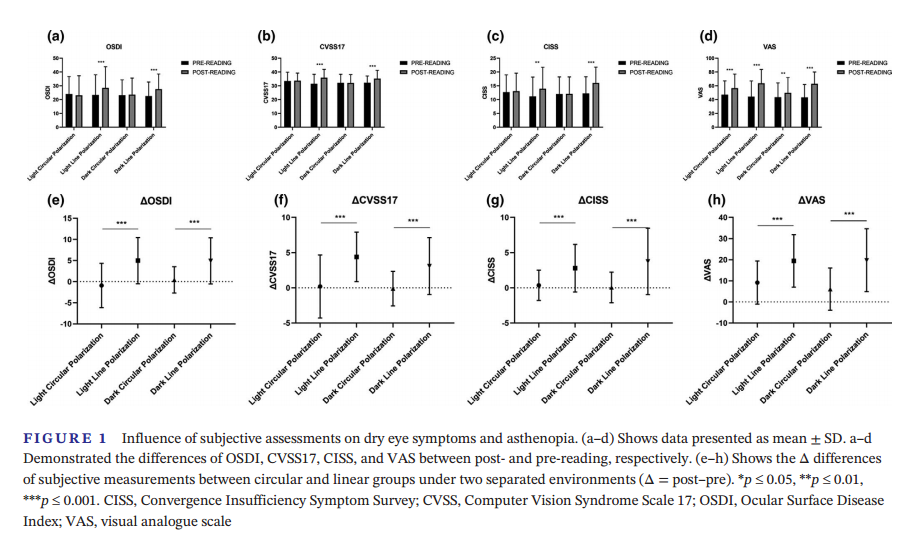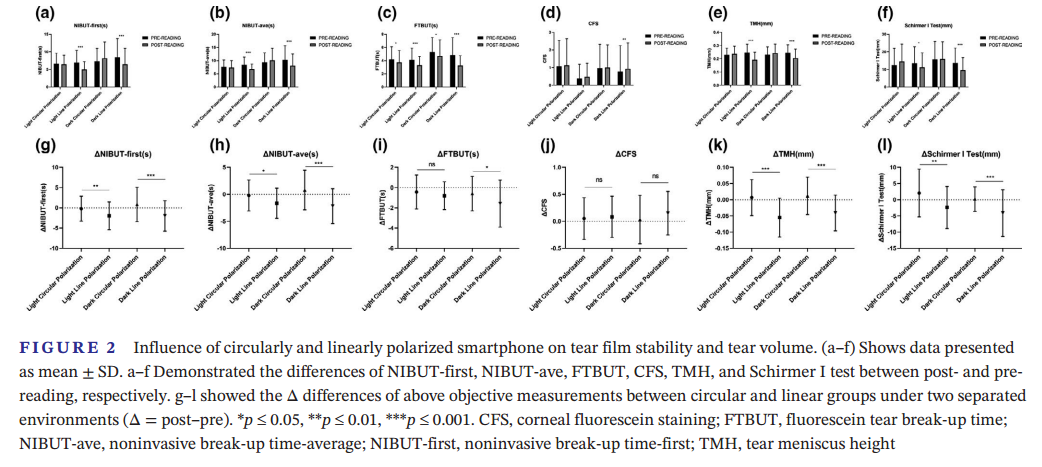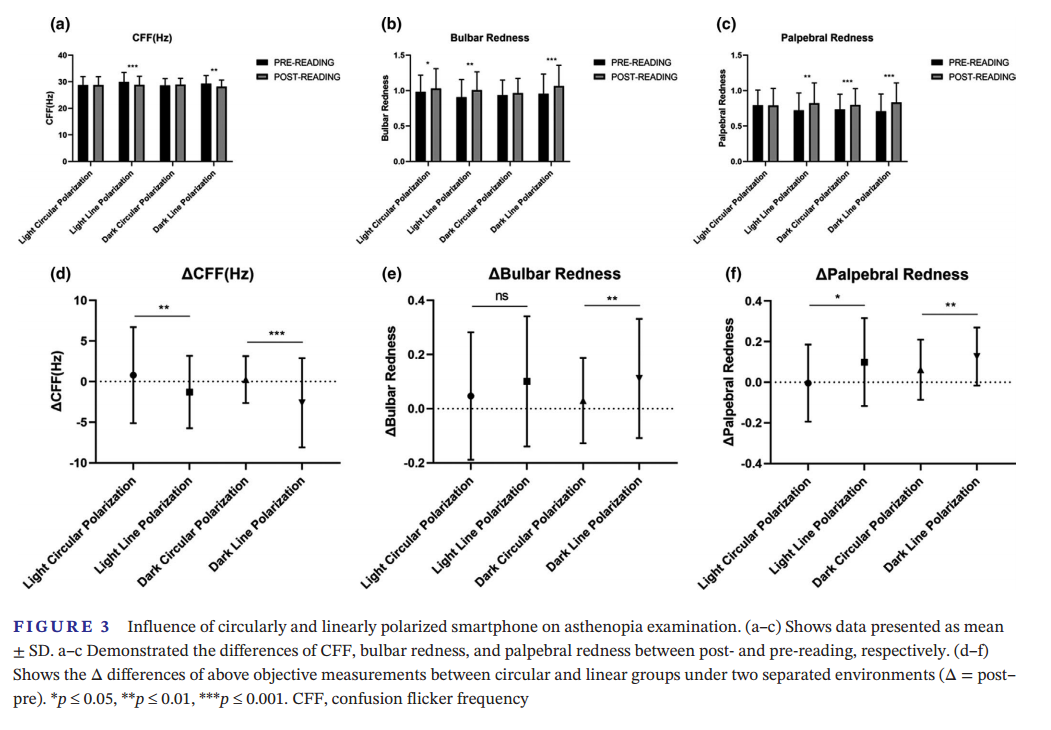Smartphones and dry eye symptoms: a study of the influence of different polarized light on ocular health
Time: Nov 05,2024
Introduction
In the past 20 years, the rapid development of smartphones has led to a surge in the number of Video Display Terminals (VDTs) users from 16 million to 4.68 billion, especially among young people aged 16 to 29 years old, 91% of whom own digital devices. However, the widespread use of VDTs affects blinking frequency and tear secretion, and even leads to ocular discomforts such as dry eye, eye pain, and eyestrain.
To reduce health risks and improve smartphone design, it is particularly important to explore the influence of different polarized light. Therefore , this study aims to compare the influence of circularly polarized light and linearly polarized light smartphones on dry eye and asthenopia symptoms in light and dark environments to find a better user experience.
Methods
In this study, 120 volunteers were recruited and randomly divided into four groups. (circularly polarized light and linearly polarized light, respectively in light and dark conditions, each group was assigned 30 subjects.) The study was conducted at the Eye Center of the Second Affiliated Hospital of Zhejiang University and was approved by the ethics committee. Participants were required to read for two hours on a smartphone. Subjective questionnaires and objective ocular measurements for detecting dry eye and asthenopia were adopted before and after the experiments, including four subjective questionnaires, critical flicker fusion frequency (CFF), tear meniscus height (TMH), fluorescein tear break-up time (FTBUT), corneal fluorescein staining (CFS), and the Schirmer I test. The first and average values of the NIBUT (NIBUT-first and NIBUT-ave) were also recorded. Both the right and left eyes were examined.
Results
In total, 120 volunteers, including 37 men and 83 women, completed the study. The mean age of all subjects was 25.86± 2.31 years. All participants were of Chinese ethnicity.

Table 1 shows the baseline information of all participants before the 2-h reading and no statistically significant difference was found among the four groups at the baseline.
The use of light linearly polarized and dark linearly polarized smartphones significantly increased ratings of subjective dry eye and asthenopia symptoms under different lighting conditions, whereas the change in ratings was not significant for smartphones with circularly polarized light. The significant difference in the effects of the two types of polarized light on dry eye and asthenopia symptoms suggests that linearly polarized light may have a greater negative impact on eye discomfort. The results are shown in Figure 1 .

The use of linearly polarized smartphones significantly reduced ocular stability metrics (e.g., NIBUT, FTBUT, and tear volume), whereas circularly polarized light smartphones had no significant effect on these metrics. This suggests that linearly polarized light may have a negative impact on ocular health, leading to a decrease in tear stability and volume. The results are shown in Figure 2.

The use of linearly polarized smartphones significantly reduces critical flicker fusion frequency (CFF) and causes conjunctival redness, whereas circularly polarized light smartphones also cause redness in both light and dark conditions, but to a relatively lesser extent. This indicates that linearly polarized light causes more significant eye irritation and discomfort. The results are shown in Figure 3.

Discussion
Our study was the first to focus on the influence of the light polarizations of smartphones on eye-related problems. In this study, we investigated and evaluated the performance of circularly polarized light from a smartphone in affecting dry eye symptoms and asthenopia by comparing with a linearly polarized smartphone in both light and dark environments. Results indicated that reading on a linearly polarized smartphone contributed to inducing dry eye and asthenopia, whereas circularly polarized smartphone tended to reduce.
It was found that FTBUT, NIBUT, tear volume and other indexes decreased significantly after using linearly polarized smartphone, while the circularly polarized light group did not have these changes. This may be related to the polarization properties of light: the electric vector vibration of linearly polarized light has a fixed direction, while the vibration of circularly polarized light is closer to the distribution of natural light, and the eye adapts better to circularly polarized light.
We also assessed ocular symptoms using questionnaires such as the OSDI, CVSS17, CISS, and VAS, which showed a significant increase in symptoms with the use of linearly polarized smartphones, whereas no change was seen with the use of circularly polarized light smartphones. This suggests that the vibrational properties of light may affect tear film stability and ocular comfort.
Although there are some limitations in this study, such as the sample size and short study time, the results suggest that prolonged use of linearly polarized smartphones may aggravate ocular discomfort. We suggest that future studies should focus on the long-term effects of light polarization on ocular health.
Conclusion
In conclusion, linearly polarized smartphones may cause dry eye and visual fatigue, while circularly polarized light smartphones seem to be more suitable for long-term use and are effective in reducing ocular discomfort.
Reference: Mou Y, Shen X, Yuan K, et al. Comparison of the influence of light between circularly polarized and linearly polarized smartphones on dry eye symptoms and asthenopia[J]. Clinical and translational science, 2022, 15(4): 994-1002.
Related News


